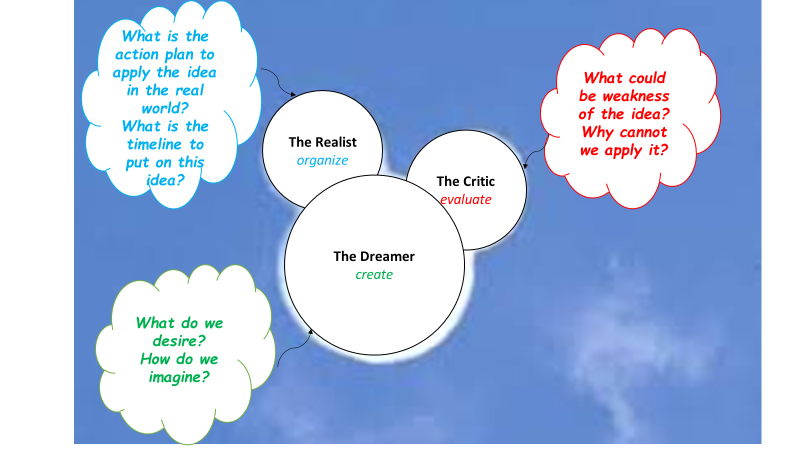The First Coffee & Coaching Session by Women in Preventive Cardiology (WIPC) Working Group
The Women in Preventive Cardiology (WIPC) working group had our first formal meeting in January 2021 with the purpose “to support and mentor women in preventive cardiology and to advocate for women’s cardiovascular health by promoting optimal treatment and transdisciplinary research to improve women’s cardiovascular outcomes.”
To achieve this goal, the WIPC presented the first Coffee & Coaching session during the ASPC 2021 Virtual Summit on CVD Prevention. Suvasini Lakshmanan MD, who is a cardiology fellow, WIPC working group member, and certified Life Coach taught WIPC and conference attendees one of the most effective and assertive creative thinking methods: Disney Creative Thinking Strategy.
What is the Disney Creative Thinking Strategy?
Creative planning is usually challenging to transform imaginative thinking into a viable reality. Among the variety of tools to empower creativity thinking – Reserved Brain Storming, Six Thinking Hats, De Bono, Lego Serious Play - the Disney Creativity Strategy is a feasible and straightforward method that was inspired by Walt Disney. Without a doubt, Walt Disney was one of the most talented innovators in the last 2 centuries, who knows how to convert dreams (creative ideas) into reality. “There were actually three different Walts: the dreamer, the realist, and the spoiler. You never knew which one was coming to the meeting”, he used to say.
In 1994, Robert Dilts, a Neuro-Linguistic Programing expert transformed Walt Disney’s strategy into a structured method for turning dreams into reality. This method forms a bridge by generating an innovative creative idea into a concrete reality, passing through a constructive critique.
Robert B. Dilts explained the Disney Creative Strategy in detail: “Creativity as a total process involves the coordination of these three subprocesses: dreamer, realist, and critic. A dreamer without a realist cannot turn ideas into tangible expressions. A critic and a dreamer without a realist just become stuck in perpetual conflict. The dreamer and a realist might create things, but they might not achieve a high degree of quality without a critic. The critic helps to evaluate and refine the products of creativity.”

Robert Dilts
How to prepare for Disney’s Creative Strategy?
- Create Space: Making different spaces for each group will assist the team members to easily switch roles and transfer to the next stage and mindset. If you do not have enough space to change rooms, you can dedicate different corners of one room for each stage/phase. As a suggestion, different background music or changing into different outfits (for longer sessions such as retreats) also could be an alternative.
Specify the team members’ roles. The team members can be separated into 3 different groups: dreams, realistic and critic; or as an alternative, the team members can switch roles in the following orders:
- DREAMER
- REALIST
- CRITIC
- Start with the “Dreamer Phase”: Everybody in the team needs to be clear that the Disney Creative Strategy is required to follow the order and start with the Dreamer role. In this phase, we do not put any limitations on imagination, creativity, and brainstorming. We do not entertain any barrier or limitation such as deadlines, financial concerns, or guidelines.
- Transition to the “Realist Phase”: After giving plenty of time to everyone for brainstorming and sculpting their dream, then let them switch to the Realist role. In this phase, you will polish and tailor your idea to make them more tangible and real. You will think to find a logical planning style, schedule, and revisit the ideas to achieve your idea.
- Concluding with the “Critic Phase”: In this phase, you will pretend as a pessimist (a.k.a. naysayer) person. You will look at your ideas from a critic standpoint who will try to make constructive critique and find why the idea is not viable. In this phase, the team members need to criticize the idea, find the weaknesses, and refine it until it gets as promising as possible.
Summary and take-home messages:
- The goal of Disney’s Creative Strategy is to reach a concrete creative idea with a solid action plan.
- Make sure that the team has enough time to flourish their imagination and hone their ideas.
- You may find it very conflicting to balance between the different roles – Dreamer to Realist to Critic- but all three roles are essential for effective project planning if they will come in the correct order.

As expected, the session allowed for all participants to connect meaningfully on common problems that we face as caregivers, especially during the pandemic and through the various roles of the realist/dreamer and critic, as a group we were able to take away some comfort, hope, and practical solutions.
In addition to inspiring the Disney Creative Thinking Strategy session, Dr. Sherry-Ann Brown, Cardiologist, Author, Poet, and WIPC Working Group Co-Chair concluded the session with one impressive and original poem. This poem stunningly relates to all of us as clinicians who do not treat the patients as a physical body but as wholeness, and how our patients can and should protect each other, as we protect ourselves and each other as well.
The Healer Speaks
My dearest patient:
When I see the hurt in you,
I want to reach out
And wrap myself around you,
To protect you.
I cannot myself take the pain from you,
I cannot shield you from the damage
Of deterioration and injury.
Yet, when you hurt I hurt,
When you heal I heal.
You shouldn't hurt alone.
I am honored to hurt with you.
I am honored to hurt for you.
The Patient Speaks
My dearest doctor:
Do not hurt for me.
Do not hurt with me.
Let me hurt without you,
For my hurt is temporary,
And I will heal.
Whether physically,
Or perhaps spiritually.
I fear your hurt is irreversible,
And you may not heal.
While you protect me,
Who will protect you?
Since I cannot protect you,
How will you protect yourself?
The Healer Responds
My dear patient:
I suspect
You are right.
Thank you for releasing me,
To protect myself too.
To care for myself too.
To heal myself too.
To gain healing
In the midst of others too.
Thank you for helping me see
That first I have to take care of me.
